
The KFBG Incense Tree Conservation Project
- Illegal logging is a major threat to the population of Aquilaria sinensis (Incense Trees) in Hong Kong.
- KFBG is looking into the genetic diversity of Incense Trees using DNA fingerprinting, as very little is known about its ability to adapt and survive natural disaster and human impacts.
- There is an urgent need to study and conserve the population of Incense Trees in Hong Kong, as this species is predicted to have great impact on the forest ecosystems in Hong Kong.
Cultural background of the traditional use of incense
The Incense Tree is so called, because it produces a strong-smelling resin in response to the presence of a fungus. This resin is called Gaharu in Indonesia, Oud in Arabia, and Chen Xiang (沈香) in Chinese. Resins can be collected and be made into incenses. There is a big market for incenses, as they are frequently burned at religious ceremonies, and also recreationally. Agarwood is most popular in Asian and Arabian countries. The spiritual association of agarwood in many cultures has been recorded in some of the world’s oldest written texts – the Sanskrit vedas, and the bible (Al-Woozain, 2016). Its significance goes beyond the burning of joss sticks and incense chips at ceremonies. In the Near East, in most of the Arabian Peninsula, oud (agarwood) is synonymous with hospitality, and it is believed that the smell can drive away depression, and produce a feeling of joy (Al-Woozain, 2016).
There are currently 21 identified species classified within the Aquilaria genus. The agarwood and resin from different species varies in its specific properties, and the quality also varies between species and localities, leading to a large variation in value of wood and resin from different sources (Oudselection, 2016). All species are currently listed as vulnerable to critically endangered on IUCN Red List.
Experts believe that the quality of the resin collected from Incense Trees is also heavily influenced by the age of the tree. It has been suggested that it takes over a century for the resin in Incense Trees to develop into top quality resins for collection (Al-Woozain, 2016). This makes sustainable harvesting of resin from Incense Trees impractical, as the development time is so long. It also highlights a major problem – that many illegal loggers are indiscriminate about the age of trees they cut down. This means many trees are felled before they have had a chance to fully develop their precious resource, and immature trees may not provide much resin at all.
The trade of agarwood is a vicious cycle. The demand for resin increases as it becomes rarer, and that in turn drives up the price further and creates an underground industry and a black market. A report in 2013 showed that oud sales has gone up by 68%, value at 3 billion USD globally (Al-Woozain, 2016). The top quality oud, referred to ‘kynam’, is described as the rarest wood on earth, and it can fetch a price that is 30 times higher than gold (Al-Woozain, 2016). The price and value of some of the best quality agarwood has led to an increasing amount of people investing in them, much like investment in famous artwork.
In China, an additional threat to the Incense Tree’s survival is caused by its use in traditional Chinese medicine (TCM) to relieve pain, asthma, and help with vomiting and hiccups dating back to the Song Dynasty. This market means loggers often target the species to sell the wood. Aquilaria sinensis, the species endemic to China and also found in Hong Kong SAR is mainly used for that purpose and, is currently under a major threat of poaching and illegal logging because of recent increase in use of TCM. Due to the great commercial value, Aquilaria sinensis has become a major target of exploitation, and is currently listed as ‘vulnerable’ by the IUCN (Lee & Mohamed, 2016).
The impact of poaching on the ecology and genetic diversity of Incense Trees in Hong Kong
Aquilaria sinensis (Incense Tree) is a sun-loving species, mainly reproducing in canopy gaps caused by large fallen trees after storm damage. They used to be common in Hong Kong’s remaining old grown forests such as feng shui woods, (Chen et al, 2016), but the future of this species in Hong Kong is of immediate concern because of on-going poaching. Once the mature trees are gone, seedlings and young trees need bright light conditions to grow but such conditions are not common in the dense secondary forests of Hong Kong, making a natural recovery of that species questionable. There has been a recent explosion of illegal logging, which have had detrimental effects on the population density and genetic diversity of the species (Jim, 2015).
The catastrophic decline of the population of Incense Trees may have caused a huge loss of genetic diversity, therefore scientists are advising that there is an immediate need for a conservation genetic study in Hong Kong (Chen et al, 2016) to inform future management plans. It is currently unknown how the population of trees will respond to this reduction in variation, but it may badly affect the ability of the species to survive and reproduce. A reduction in variation may also make the population more vulnerable to changes in the environment in particular climate change, and more susceptible to diseases (Lee et al, 2018). Planting activities should therefore be informed by scientific knowledge, and KFBG has put in a substantial amount of effort looking into genetic diversity of the population of Aquilaria sinensis in the genetic laboratory on site.
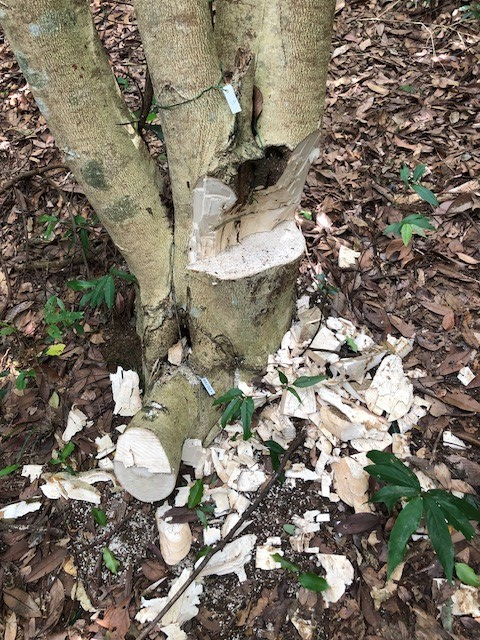
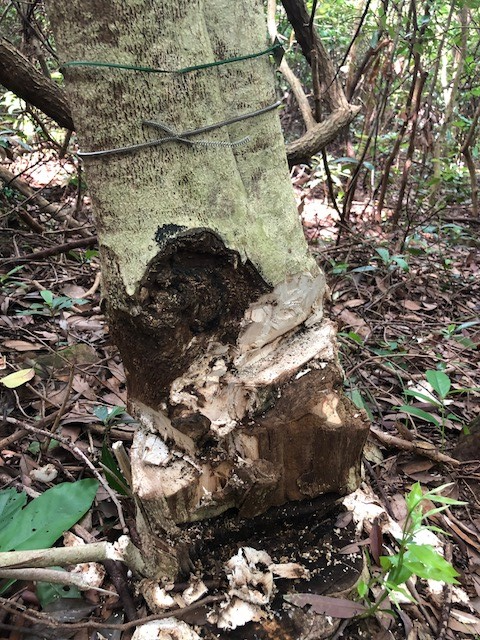
Fresh cuts were found on a couple of Incense Trees at KFBG on 4 August 2018.
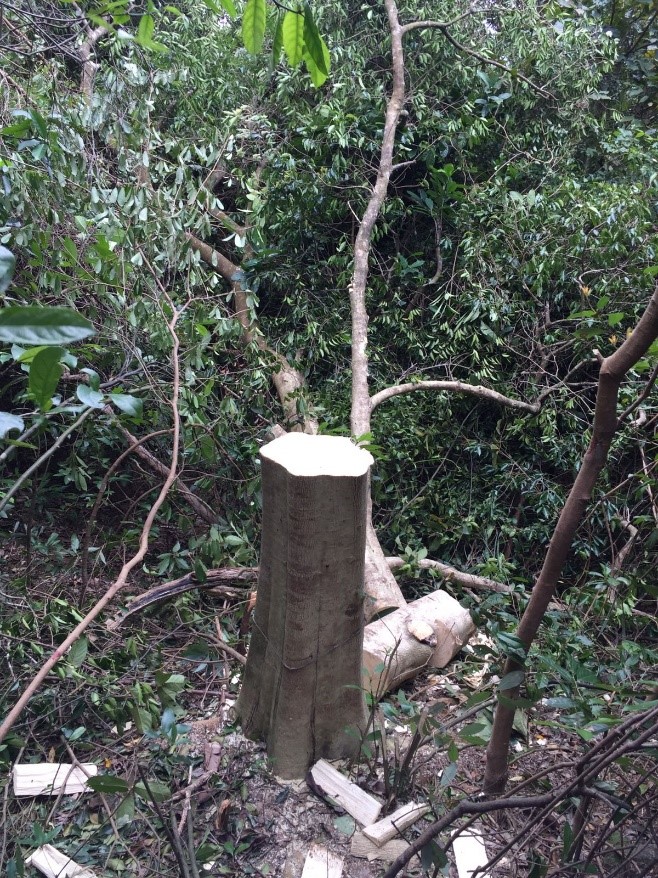
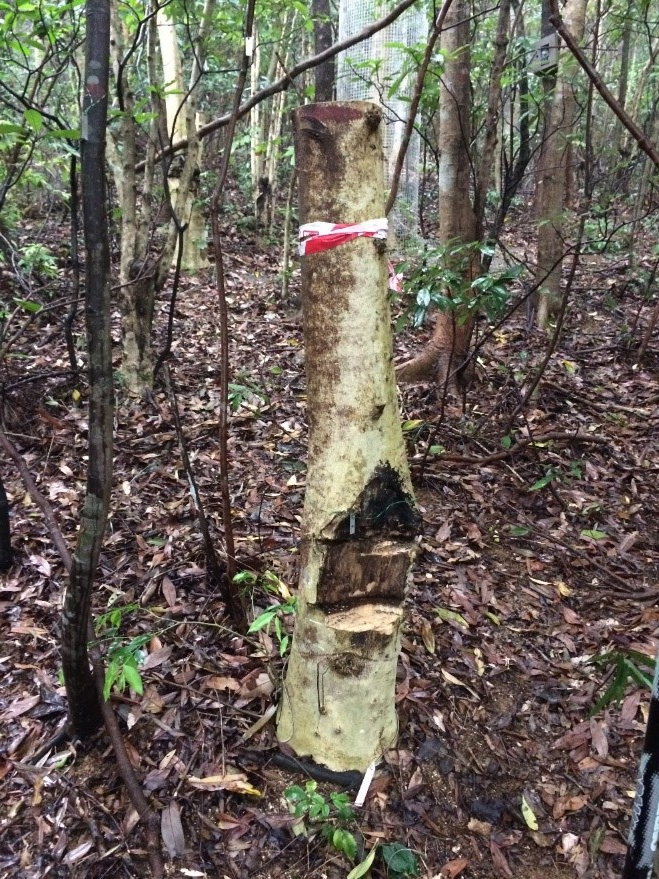
Pictures showing an Incense Tree being cut down, and the other wounded for resin.

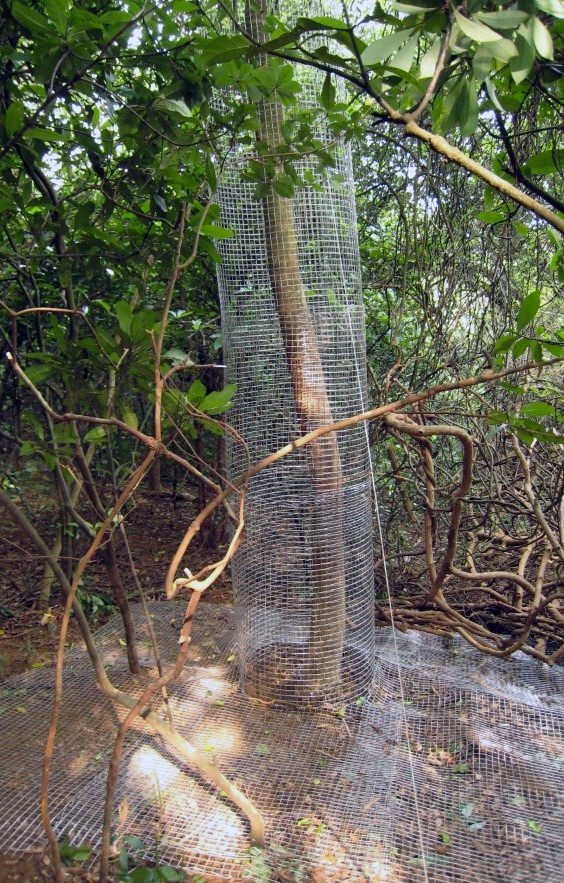
Implementation of tree cages to prevent poachers from cutting down the trees.
The importance of genetic diversity for maintaining healthy populations
Genetic diversity is the variation in genetic makeup among individuals in a population. A larger genetic diversity in a population improves the chances of survival in changing environments, particularly when facing strong pressures caused by natural disasters, and human impacts (Lee et al, 2018). When the environment changes, some individuals may have particular genetic make-ups which allow them to survive better than other individuals (Jia et al, 2010). This genetic make-up will therefore be favoured by selection, and will lead to adaptation and evolution of the species over time. In a more genetically diverse population, there is a higher chance that some individuals will have a genetic make-up that allows them to survive well, and therefore there is a higher chance that the population will survive through changes in the environment, such as climate change.
KFBG is looking into the impact of illegal logging on the genetic diversity of Aquilaria sinensis. It is assumed that the genetic diversity of planted population would be much lower than the natural population unless informed management plans could be soon devised. Low levels or absence of gene flow among populations is a characteristic of many rare and endangered species (Schierenbeck, 2017). Human interference, such as logging, decreases mating opportunities between genetically unrelated individuals (Chen et al, 2016). An uninformed act of replanting could only increase the population size, but not genetic diversity. Thus the ability to survive cannot be achieved by the mere act of replanting.
At the moment very little is known about the current genetic diversity of KFBG’s population of Incense Trees, therefore there is an urgent need to study the conservation genetics of this species. The amount of genetic variation present within a population is thought to determine its adaptability for long-term survival (Lee et al, 2018). We are currently using DNA fingerprinting in our genetic laboratory to look into the genetic diversity of the population in KFBG, and compare with other populations found in Hong Kong.
Pictures from behind the scene
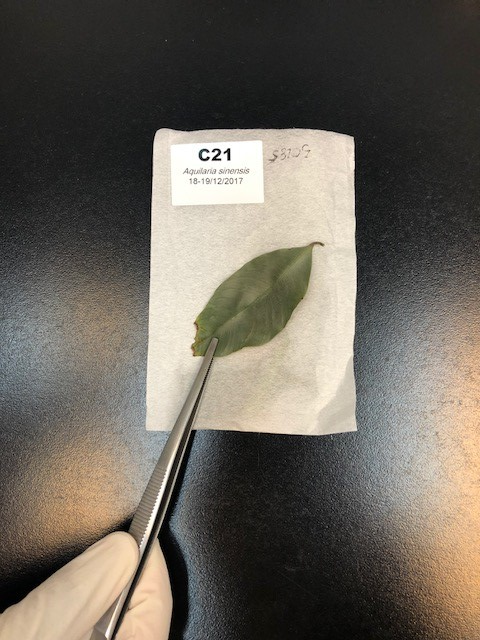
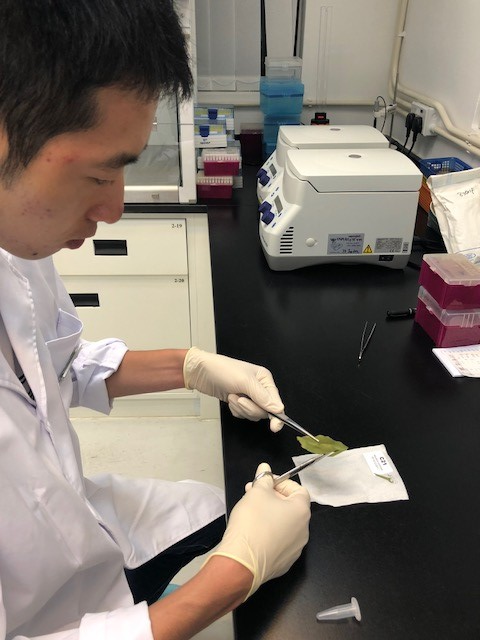
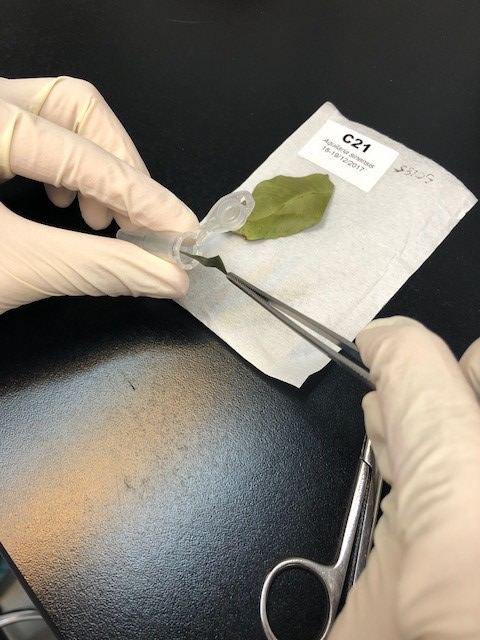
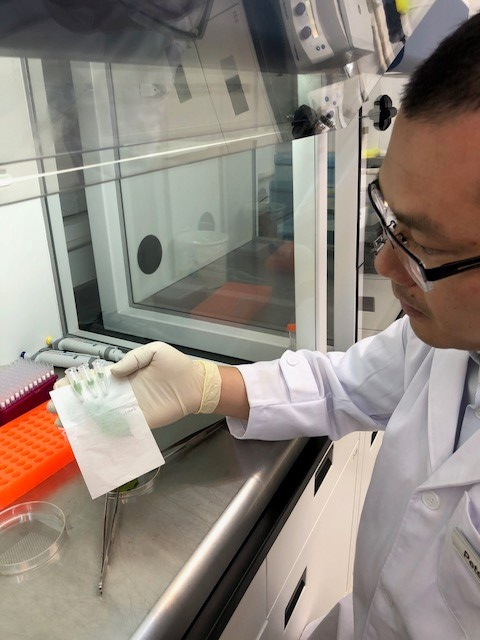
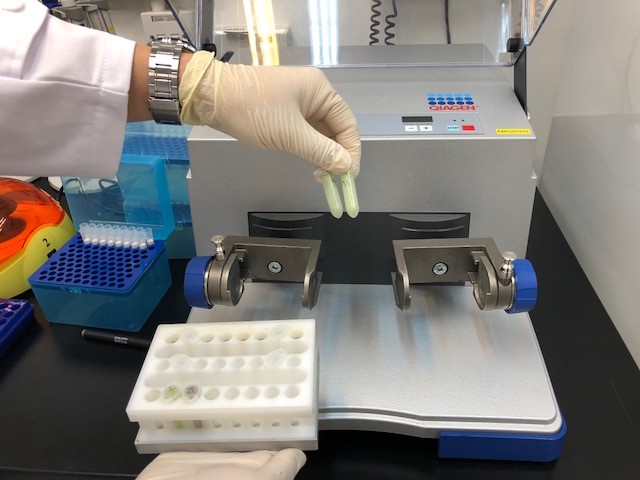

KFBG management of Aquilaria sinensis
Recent research has looked into the genetic diversity of cultivated Aquilaria sinensis in protected areas, however there is very limited research looking at populations in natural habitats (Chen et al, 2016). KFBG site is special in that it serves as a natural habitat for the species. The goal of the research is to implement suitable conservation and management strategies of Aquilaria sinensis, in order to achieve a successful recovery and maintain a healthy population of the species in KFBG.
There are two directions in the management of populations of Aquilaria sinensis in KFBG. On one hand, KFBG is managing the population of trees that are found on site with the implementation of the seed garden project for ex-situ conservation, and a project on improving the protection of the species within KFBG by the set-up of steel cages around the trees, real time surveillance with cameras and regular patrolling. On the other hand, we are also trying to come up with conservation plans to plant and sustain a genetically diverse population within KFBG’s premises. We hope to develop better conservation strategies from our experiences, and to share our knowledge on protecting and conserving the species in Hong Kong.
Understanding genetic diversity of the populations of Aquilaria sinensis is the foundation of informed implementation and formulation of conservation management strategies for forest in KFBG.
Click here to watch a documentary about the current situation on production of resin
References
Al-Woozain, A. M. (2016). Scent from heaven. Qatar: Al-Jazeera
Chen, G., Liu, C. & Sun, W. (2016) Pollination and seed dispersal of Aqularia sinensis (Lour.) Gilg (Thymelaeaceae): An economic plant species with extremely small populations in China. Plant Diversity 38(5), pp. 227-232
Jia, W. J., Li, E. X., Yang, B. Y., & Liu, D. X. (2010) Studies on genetic diversity of Aquilaria sinensis. Journal of Tropical and Subtropical Botany 18(2), pp. 159-164.
Jim, C. Y. (2015) Cross-border itinerant poaching of agarwood in Hong Kong’s peri-urban forests. Urban Forestry & Urban Greening 14, pp. 420-431.
Lee, S. Y. & Mohamed, R. (2016) The origin and domestication of Aquilaria, an important agarwood-producing genus. Agarwood: Science Behind the Fragrance, pp. 1-20.
Lee, S. Y., Ng, Wei. L., Lamasudin, D. U., & Mohamed, R. (2018) Inter-simple sequence repeat markers reveal genetic relatedness between natural Aquilaria populations in Peninsular Malaysia. Chiang Mai Journal of Science 45(3), pp. 1307-1317.
Manohara, T. N. (2013) Wasp-mediated seed dispersal in agarwood plant (Aquilaria malaccensis), a critically endangered and overexploited species of North East India. Current Science 105, pp. 298-299.
Oudselection. (2016, December 11). Do you know all the different species of agarwood trees? http://www.oud-selection.com/blog/know-different-species-aquilaria-trees/?locale=en
Schierenbeck, K. A. (2017) Population-level genetic variation and climate change in a biodiversity hotspot. Annals of Botany 119(2), pp. 215-228.
